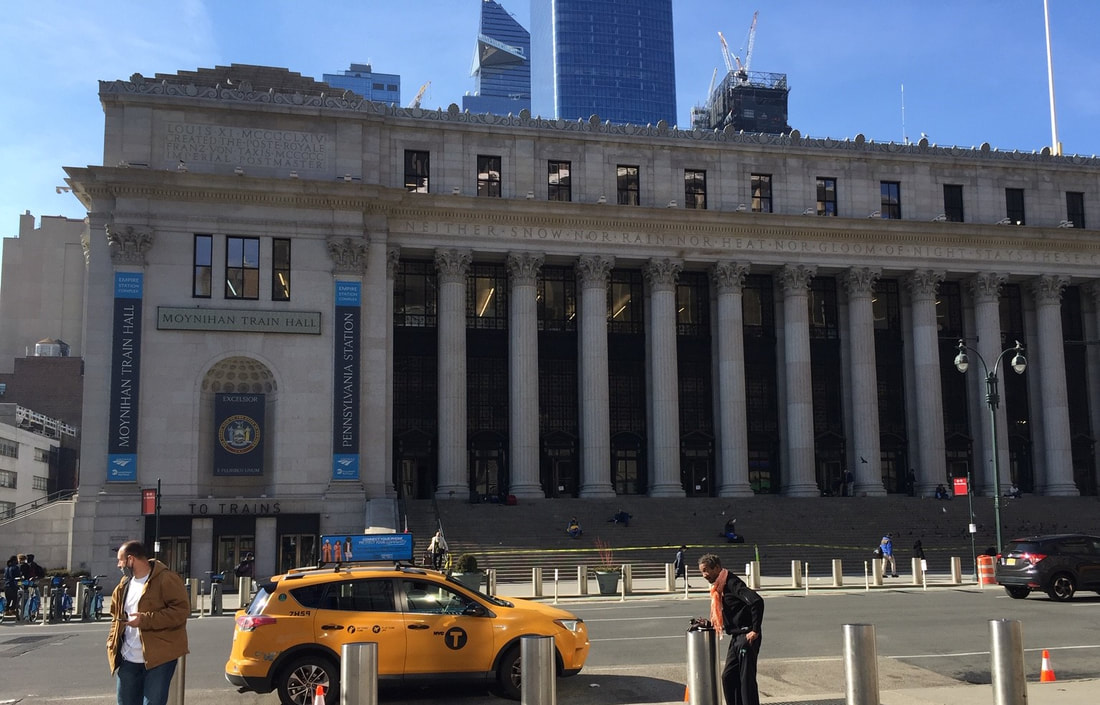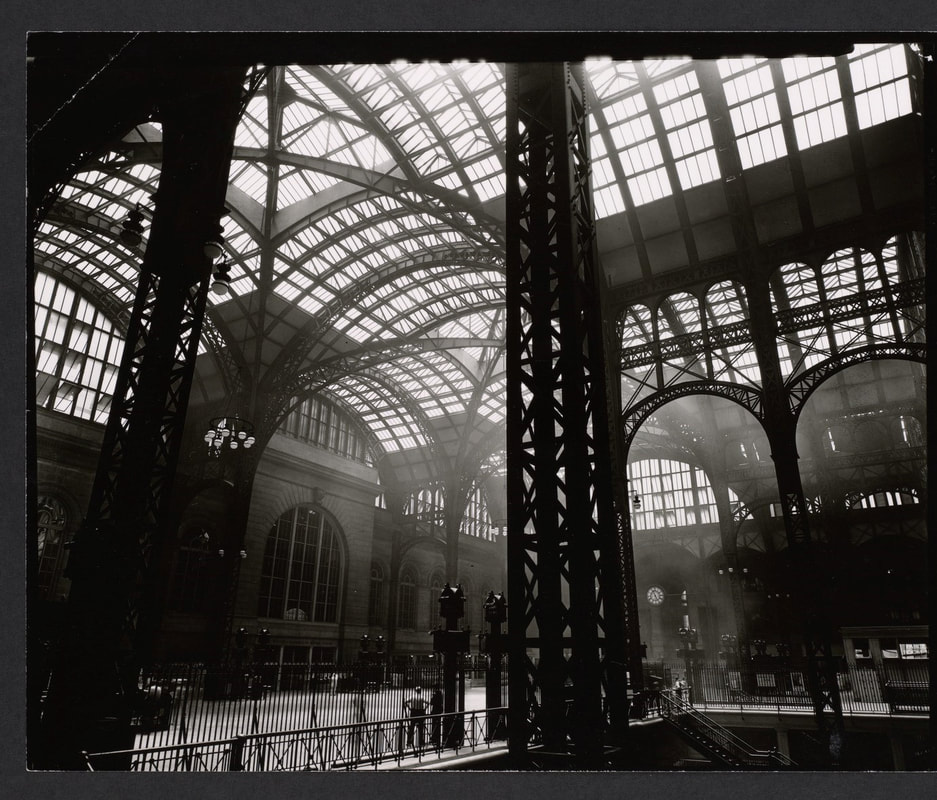|
By Laurie Lewis In the past year, most of us have stayed fairly close to home. When you’re ready to venture a little farther and decide to give Amtrak some business, you’ll be in for a pleasant surprise if you’re using New York’s Penn Station. For more than fifty years, Penn Station was a crowded, dreary, airless depot. Now you will be entering or leaving the city through the Moynihan Train Hall. The new Moynihan Train Hall, in the Farley Post Office Building The addition is both new and old. The Moynihan Train Hall, which opened on January 1 of this year, occupies the lower levels of the Farley Post Office, directly across Eighth Avenue from the old Penn Station. Built in 1913 by the architectural firm McKim, Mead & White—the firm that built the original Penn Station in 1910 in the same Beaux-Arts style—the post office building has the stately outward appearance of an early twentieth century civic structure. In the interior of the building, in the central space that was once the post office’s main sorting room, a 92-foot-high skylight fills the concourse with light and air. The skylight itself is new, but it is supported by massive steel trusses that were part of the original post office building. Skylit concourse of Moynihan Train Hall The Moynihan concourse evokes the vaulted center and exposed steel beams of the original Penn Station—Penn 1.0, as it were. If you’re old enough to have taken a train into or out of New York City in the first half of the twentieth century, you might remember that building in its heyday. The huge waiting room, modeled after the Baths of Caracalla in ancient Rome, was even taller than the concourse in the Moynihan Train Hall, soaring to a height of 150 feet. Marble columns inside and out enhanced the feeling of antiquity. Boarding concourse of the original Penn Station In its first full year of operation, Penn 1.0 saw 10 million travelers. Train ridership steadily increased until 1945. Then more and more intercity travelers opted for car trips or took to the skies. By the mid- to late-1950s, the Pennsylvania Railroad, owner of Penn Station, could not keep up with the expense of operating the huge facility for the dwindling passenger population. Demolition began on McKim, Mead & White’s masterpiece in 1963. Dismantling of the station did not halt train traffic. Trains still ran along the tracks that Penn’s architects had positioned far beneath the station and neighboring post office. To buy tickets and reach the trains, passengers now passed through a subterranean maze that also was called Penn Station; this would be Penn 2.0—the facility you might have used in recent memory. Intended to serve 200,000 people a day, weekday usage eventually soared to three times that amount, making it the country’s busiest rail hub. Penn Station was jam packed, especially during rush hour or when problems occurred on one of the rail systems feeding into the station (Amtrak, Long Island Rail Road, and New Jersey Transit, as well as several subway lines). Overcrowding was already a major problem in Penn 2.0 by the 1990s. Daniel Patrick Moynihan, then U.S. Senator from New York, suggested alleviating the congestion by diverting passengers to the cavernous and underutilized post office building across the street. Decades of proposals and rejections ensued. Finally, Moynihan’s vision has come to fruition. The new Moynihan Train Hall and the subterranean Penn form a third iteration: Penn 3.0. Amtrak and Long Island Rail Road customers use the new hall, whereas New Jersey Transit remains in the old facility. The two buildings connect seamlessly beneath the concourse level, assuring a dry passage on rainy and snowy days. Whether using the underground route or crossing Eighth Avenue, hungry travelers for now can find food vendors in the old building. A food hall will open in the Moynihan building in the fall. By then, hopefully, the pandemic will be over and more people will be taking trips for business or pleasure and returning to offices in the city. Some of those office workers will be Facebook employees who will have new digs above the Moynihan concourse. Other visitors to the building might be going to the post office, which still operates on the Eighth Avenue side. Yet others may be coming simply to see this vast improvement over the Penn Station they loved to hate. Some Amenities Planned for Moynihan Train Hall*
Learn More About Penn Station on Jane's Walk Every May, cities around the globe host Jane’s Walk, which honors Jane Jacobs, an urban activist and long-term Greenwich Village resident. Usually held the first weekend in May, Jane’s Walk is an opportunity to explore various city places with other interested people. Best of all, it’s completely free! Like so many other activities during the pandemic, Jane’s Walk has switched to a virtual format this year. Although you won’t be able to take in-person walks, you will have plenty of opportunities to participate. The Municipal Art Society, the New York sponsor of Jane’s Walk, has expanded the festival from a weekend to a week-long event. I will be leading a virtual Jane’s Walk called The New Penn, the Great Penn. I’m offering it twice: on Tuesday, May 4, at 6 PM, and on Friday, May 7, at 3 PM. You’ll learn more about the various Penn Stations and be able to share your opinions and experiences in this short Zoom event. You must register in advance to receive the Zoom link. To see the full roster of this year’s Jane’s Walk and to register for my virtual tour of Penn Station, go to www.mas.org/janes-walk-nyc-2021. Tours
Scheduled in-person tours are suspended during the coronavirus pandemic. If you would like ideas for private tours, please see our website. Comments are closed.
|
Archives
April 2024
|





